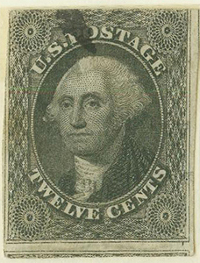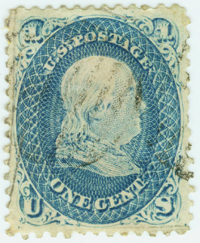
Discussion - Member to Member Sales - Research Center

Discussion - Member to Member Sales - Research Center

When I was working in engineering I used one of these, and it has taken me all these years to finally decide to locate one for stamp use.
It is a Mitutoyo thickness gauge and is ideal for thickness measurements.
see one here
Altho a micrometer will work, it is hard to consistently control the amount of pressure exerted on the material under measurement. The reason is that the force applied to the material, depends on the user properly adjusting the clutch and how fast the spindle is turned until it bottoms out on the measured material. The lack of fine control of this force, could cause the paper to be compressed too much (especially soft porous paper), and so give a inaccurate measurement.
This instrument is very sensitive and needs no clutch. The user depresses the lever and the upper anvil and spindle raise up to allow the user to insert the material between the two open anvils. The user then releases the lever and the spindle and upper anvil close on the material under measurement. An internal spring and jeweled movement controls this force and is very gentle, repeatable and consistent.
These instruments normally cost $100-$150 new, but I found this one for $44 and free shipping, on eBay. The resolution of the instrument is amazing. 360 degrees of rotation of the pointer is equal to .01" and from 0-1 (36 degrees of arc or rotation) is equivalent to .001". In between 0-1 there are ten divisions each equal to 3.6 degrees of arc or rotation. That distance is about 1/16" on the large dial and is equal to .0001" (one ten-thousandths of an inch) of thickness.
I measured several stamps and found that this instrument is so sensitive that all stamps will vary by about +/- .0002" (two ten thousandth of an inch). However if you are measuring two stamps and one is thin paper and the other is soft porous paper, the difference will likely be +/- .001-.002" or more.
Further searches revealed that there are instruments with less resolution than this one.
I'm sure the Treasury Dept uses these to detect differences in paper thickness, of suspected counterfeit banknotes.
Still just sortin'....
TuskenRaider

4 Members
like this post.
Login to Like.
Hey! We just bought one, and I don't know why. It sits in my desk drawer, waiting for me to find a use for it. Ours is graduated in 0.001, which was an error by our prez who thought we could use it for measuring surface finish tape (need 0.0001" accuracy). Nice gauge though, gotta be good for something!
In my metrology days many years ago, we called them snap gauges, although I've seen other types of instrument called that.

Login to Like
this post


Login to Like
this post
just a remark: I have never seen references to paper thickness in catalogues using absolute terms, like so-and-so many micrometres or so many thousands of inches. Just vague descriptions like thick cardboardlike paper, or cigarette paper thickness.

Login to Like
this post
As mentioned by Jansimon, a few very specialized catalogs mention thickness but it is generally in a range and often the ranges overlap.
The presence or lack of gum and how it was applied would make a notable difference
Early issues had frequent paper supply changes to further complicate things.
Anyway, an interesting tool but it probably would only have some usefulness in thick/thin paper situations that touch and feel might determine.

Login to Like
this post
Paper thickness is one of the most reliable ways to differentiate between wet and dry printings. I would refer you to a "Stamp Smarter" article linked below. It has been the only way for me to separate the wet and dry printings of Australia C1.
http://stampsmarter.com/learning/Manuf_WetDryPrintingMethods.html

1 Member
likes this post.
Login to Like.
The stamp smarter article, at the bottom, inadvertently shows the most reliable way, in may cases, to identify wet/dry printings, modern type differences, etc.
Plate number singles.
They are incredibly affordable and unambiguous for most US stamps. They don't fully identify a stamp EVERY time, but they are really quite helpful if you collect mint stamps.
Lars

1 Member
likes this post.
Login to Like.
Many varieties can be found in the Soviet occupation zone in Germany. Thüringen is a good example, the first issue has a range of paper thickness from 0.06 to 0.105. I use a Mitutoyo "Quick mini". It´s a nice small hand size. I ordered it through the company I work for so got it a little less expensive.


1 Member
likes this post.
Login to Like.

Hi Everyone;
When I was working in engineering I used one of these, and it has taken me all these years to finally decide to locate one for stamp use.
It is a Mitutoyo thickness gauge and is ideal for thickness measurements.
see one here
Altho a micrometer will work, it is hard to consistently control the amount of pressure exerted on the material under measurement. The reason is that the force applied to the material, depends on the user properly adjusting the clutch and how fast the spindle is turned until it bottoms out on the measured material. The lack of fine control of this force, could cause the paper to be compressed too much (especially soft porous paper), and so give a inaccurate measurement.
This instrument is very sensitive and needs no clutch. The user depresses the lever and the upper anvil and spindle raise up to allow the user to insert the material between the two open anvils. The user then releases the lever and the spindle and upper anvil close on the material under measurement. An internal spring and jeweled movement controls this force and is very gentle, repeatable and consistent.
These instruments normally cost $100-$150 new, but I found this one for $44 and free shipping, on eBay. The resolution of the instrument is amazing. 360 degrees of rotation of the pointer is equal to .01" and from 0-1 (36 degrees of arc or rotation) is equivalent to .001". In between 0-1 there are ten divisions each equal to 3.6 degrees of arc or rotation. That distance is about 1/16" on the large dial and is equal to .0001" (one ten-thousandths of an inch) of thickness.
I measured several stamps and found that this instrument is so sensitive that all stamps will vary by about +/- .0002" (two ten thousandth of an inch). However if you are measuring two stamps and one is thin paper and the other is soft porous paper, the difference will likely be +/- .001-.002" or more.
Further searches revealed that there are instruments with less resolution than this one.
I'm sure the Treasury Dept uses these to detect differences in paper thickness, of suspected counterfeit banknotes.
Still just sortin'....
TuskenRaider

4 Members
like this post.
Login to Like.
07:17:06pm
re: Best way to accurately measure stamp paper thickness
Hey! We just bought one, and I don't know why. It sits in my desk drawer, waiting for me to find a use for it. Ours is graduated in 0.001, which was an error by our prez who thought we could use it for measuring surface finish tape (need 0.0001" accuracy). Nice gauge though, gotta be good for something!
In my metrology days many years ago, we called them snap gauges, although I've seen other types of instrument called that.

Login to Like
this post

re: Best way to accurately measure stamp paper thickness


Login to Like
this post

Auctions - Approvals
re: Best way to accurately measure stamp paper thickness
just a remark: I have never seen references to paper thickness in catalogues using absolute terms, like so-and-so many micrometres or so many thousands of inches. Just vague descriptions like thick cardboardlike paper, or cigarette paper thickness.

Login to Like
this post

re: Best way to accurately measure stamp paper thickness
As mentioned by Jansimon, a few very specialized catalogs mention thickness but it is generally in a range and often the ranges overlap.
The presence or lack of gum and how it was applied would make a notable difference
Early issues had frequent paper supply changes to further complicate things.
Anyway, an interesting tool but it probably would only have some usefulness in thick/thin paper situations that touch and feel might determine.

Login to Like
this post

re: Best way to accurately measure stamp paper thickness
Paper thickness is one of the most reliable ways to differentiate between wet and dry printings. I would refer you to a "Stamp Smarter" article linked below. It has been the only way for me to separate the wet and dry printings of Australia C1.
http://stampsmarter.com/learning/Manuf_WetDryPrintingMethods.html

1 Member
likes this post.
Login to Like.

re: Best way to accurately measure stamp paper thickness
The stamp smarter article, at the bottom, inadvertently shows the most reliable way, in may cases, to identify wet/dry printings, modern type differences, etc.
Plate number singles.
They are incredibly affordable and unambiguous for most US stamps. They don't fully identify a stamp EVERY time, but they are really quite helpful if you collect mint stamps.
Lars

1 Member
likes this post.
Login to Like.

re: Best way to accurately measure stamp paper thickness
Many varieties can be found in the Soviet occupation zone in Germany. Thüringen is a good example, the first issue has a range of paper thickness from 0.06 to 0.105. I use a Mitutoyo "Quick mini". It´s a nice small hand size. I ordered it through the company I work for so got it a little less expensive.


1 Member
likes this post.
Login to Like.

